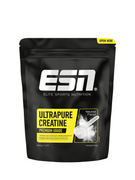Was ist Freeletics überhaupt?
Wie bereits angesprochen handelt es sich beim Freeletics Training um eine besondere Form des Eigengewichtstrainings, das sowohl in den eigenen vier Wänden als auch in einem Hotelzimmer oder Park ausgeführt werden kann. Neben dem eigenen Körpergewicht setzen manche der insgesamt 29 Standard-Workouts zusätzliche Umstände wie das Vorhandensein einer Klimmzugstange für Klimmzüge oder von ausreichend Platz für kurze aber intensive Sprints voraus. Die Übungen sind, was Anzahl der Wiederholungen und Pausen angeht, stets in einer festen Reihenfolge vorgegeben. Diese einzelnen Excercises müssen so schnell und technisch sauber wie möglich absolviert werden. Zu jeder Übung stellt Freeletics ein Video mit allen Bewegungsabläufen in Zeitlupe zur Verfügung.
Dabei unterscheidet Freeletics zwischen der anfängerfreundlichen Endurance-, der fordernden Standard- und der knüppelharten Strength-Variante der Workouts. Wird in der Endurance-Stufe noch eine Knie-Liegestütze verlangt, ist in der Standardvariante bereits eine handelsübliche Liegestütze erforderlich, während bei Strength nichts unter einer einarmigen Liegestütze (passenderweise „OH-Pushup“ genannt) geht. Prinzipiell handelt es sich beim Freeletics Training also um eine Trainingsform, die sehr stark an das High Intensitiy Intervall Training (HIIT) angelehnt ist. Weil es epischer klingt, sind sie nach Figuren der griechischen und römischen Mythologie benannt, etwa Aphrodite, Venus, Hermes oder Zeus.
Was ist das Besondere am Freeletics Training?
Das Erfolgsrezept dieser Trainingsform besteht darin, dass sie im Gegensatz zu klassischen Trainingsvarianten einen klaren Wettbewerbscharakter aufweist. Dadurch ist das Training selbst nicht nur sehr effektiv für die Ausdauer, die Fettverbrennung sowie für die Kraftausdauer, sondernfördert auch in erheblichem Maße die Trainingsmotivation und ermöglicht einen nicht zu verachtenden Muskelaufbau, wobei niemand eine Schwergewichts-Bodybuilder-Figur erwarten sollte. Das liegt in erster Linie an den zahlreichen Freeletics Communities, die es beispielsweiseermöglichen, dass Trainierende über spezielle Apps miteinander verbunden sind und so gegeneinander antreten können. Es geht also darum, seine persönliche Leistung, die im Fall der App in Punkten gemessen wird, zu verbessern und Rekorde aufzustellen. Dieser Wettbewerbscharakter ist es, der Athleten aller Leistungsklassen ebenso bei der Stange hält wie ein spannendes Online-Game mit Erfahrungspunkten und Awards. Somit ist eine wichtige Voraussetzung für den langfristigen Erfolg geschaffen.
Welche Vorteile hat das Freeletics Training?
Hinzukommt ebenso wie beim konventionellen High Intensity Intervall Training der extrem hohe Energieverbrauch in kurzer Zeit, da ein großer Teil der Skelettmuskulatur an den jeweiligen Übungen beteiligt ist. Das wiederum führt in Verbindung mit der wechselnden Trainingsintensität zumsogenannten Nachbrenneffekt, der den Energieumsatz des Organismus nach dem Training für bis zu 24 Stunden deutlich messbar erhöht. Wer also nach einem Freeletics Workout Plan trainiert, verbrennt auch im Ruhezustand zusätzliches Fett und leert die Kohlehydratspeicher der Muskulatur, so dass neu gegessene Kohlenhydrate nicht zu Fett umgewandelt werden und dort eingelagert werden können. Ein weiterer Vorzug der Programme besteht darin, dass die funktionale Kraft gefördert wird.

Dies geschieht durch die Verbesserung der intermuskulären Koordination, zumal die verschiedenen an einer Übung beteiligten Muskelgruppen mit der Zeit lernen, immer effizienter zusammenzuarbeiten. Letztendlich wirkt sich dieser Zuwachs an funktionaler Kraft nicht nur im Alltag äußerst nützlich aus, sondern auch beim Bodybuilding oder bei anderen Sportarten. Da reines Bodybuilding diesen Effekt nicht hervorrufen kann, ist das Freeletics Training eine sinnvolle Ergänzung zum Hypertrophietraining – quasi ein „besseres“ Cardio-Training, da eine ganzheitliche Belastung stattfindet.
Wie ist ein typischer Freeletics Workout Plan aufgebaut?
Freeletics Workouts zeichnen sich durch eine klare Struktur aus, was bedeutet, dass sowohl die Übungen als auch die Anzahl der Sätze sowie die Pausen und die dazugehörige Anzahl der Wiederholungen exakt festgesetzt sind. Dies dient dazu, dass die erbrachten Leistungen jederzeit mit eigenen Leistungen aus der Vergangenheit sowie mit den Leistungen anderer Athleten verglichen werden können. Dabei gibt es verschiedene Typen von Workouts. Während sich einige auf das Element Kraft konzentrieren und bei anderen die Ausdauer im Fokus steht, ist auch eine Mischung aus Ausdauer- und Kraftfokussierung möglich. Worauf der Fokus liegt, ist jeweils in der Workoutbeschreibung hinterlegt. Falls du jetzt einigermaßen verwirrt bist, weiter unten findest du aufschlussreiche Beispielstrainingspläne für einige ausgewählte Workouts.
Für wen ist das Freeletics-Training am besten geeignet?
Da es sich bei Freeletics um ein Trainingsprinzip handelt, das ausschließlich mit dem eigenen Körpergewicht ausgeführt werden kann, eignet es sich prinzipiell sowohl für Anfänger als auch für Fortgeschrittene. Das gilt besonders, da die unterschiedlichen Workouts aus Übungen mit diversen Schwierigkeitsgraden bestehen, sodass sich jeder Athlet verbessern kann und seinem Leistungsniveau entsprechend gefordert wird. Absolute Fitnessanfänger, die noch nie trainiert haben, sollten es jedoch zunächst einmal mit einem einfachen Bodyweight-Training für Zuhause versuchen, um eine gewisse Grundkraft aufzubauen.
Besonders geeignet sich das Training indes für Sportler, die allgemein fit werden oder sehr effektiv Fett abbauen möchten. Darüber hinaus bietet sich diese Trainingsform für Sportler wie Kletterer, Fußballer, Footballspieler, Handballer sowie Leichtathleten an, die in ihrer Disziplin in hohem Maße von funktionaler Kraft profitieren. Nicht geeignet sind Freeletics Workouts hingegen für Bodybuilder und Kraftsportler, denen es ausschließlich um den Aufbau von Maximalkraft und Muskelmasse geht. Diese Sportler sind mit konventionellen Trainingsmethoden deutlich besser beraten. Wer allerdings eher das Ideal der Fitnessmodels erreichen will, findet mit Freeletics eine motivierende Ergänzung für sein Training, wenn er bereit ist, im Training an seine Grenzen zu gehen.

Einige beispielhafte Freeletics Workouts
Die zahlreichen Freeletics Workout Pläne, deren Anzahl im Übrigen stetig wächst, tragen Namen bekannter Figuren aus der griechischen und römischen Mythologie und bekommen damit ein individuelles Image zugeschrieben. Während das bei vielen Frauen beliebte Einsteigerprogramm »Aphrodite« beispielsweise aus drei Übungen besteht und sich auf den Bauch und die Beine konzentriert, ist das »Zeus«-Workout mit gleich fünf Übungen, die ein komplettes Ganzkörpertraining abbilden, deutlich intensiver. Der Schwierigkeitsgrad, den jeder Freeletics Workout Plan hat, wird jedoch nicht nur durch die Art und die Menge der Übungen repräsentiert, sondern auch durch die Anzahl der Punkte, die ein Athlet für das Absolvieren gutgeschrieben bekommt. Nachfolgend einige der bekanntesten Workouts.
Aphrodite
Das Standard »Aphrodite«-Workout konzentriert sich auf die Beine und den Bauch und besteht aus Burpees, Squats und Situps, wobei die Wiederholungszahl der einzelnen Übungen mit jedem Satz abnimmt.
| Übungen | Runde 1/5 | Runde 2/5 | Runde 3/5 | Runde 4/5 | Runde 5/5 |
|---|---|---|---|---|---|
| Burpees | 50 | 40 | 30 | 20 | 10 |
| Squats | 50 | 40 | 30 | 20 | 10 |
| Situps | 50 | 40 | 30 | 20 | 10 |
Ares
Für das »Ares«-Workout wird neben dem eigenen Körpergewicht auch eine Klimmzugstange (oder etwas Ähnliches) und genügend Platz benötigt, um 40-Meter-Sprints zu absolvieren. Während es sich beim »Aphrodite«-Workout um ein Ausdauer-Workout handelt, liegt der Fokus der drei Übungen (Klimmzüge, Situps, 40-Meter-Sprints) auf der Kombination aus Kraft und Kraftausdauer.
| Übungen | Runde 1/5 | Runde 2/5 | Runde 3/5 | Runde 4/5 | Runde 5/5 |
|---|---|---|---|---|---|
| Pullups | 7 | 7 | 7 | 7 | 7 |
| Situps | 7 | 7 | 7 | 7 | 7 |
| 40m Sprint | 2x | 2x | 2x | 2x | 2x |
| Pause | 60 sec | 60 sec | 60 sec | 60 sec | - |
Gaia
Das nach Mutter Erde benannte »Gaia«-Workout ist, da es aus zehn Durchgängen besteht, tatsächlich die Mutter aller Ausdauer-Workouts im Freeletics-Bereich. Equipment wird allerdings keines benötigt. Erschwert wird das Workout dadurch, dass zwischen den einzelnen Durchgängen keine Pause eingelegt wird, was den Puls konstant oben hält.
| Übungen | Runde 1/10 | Runde 2/10 | Runde 3/10 | Runde 4/10 | Runde 5/10 | Runde 6/10 | Runde 7/10 | Runde 8/10 | Runde 9/10 | Runde 10/10 |
|---|---|---|---|---|---|---|---|---|---|---|
| Jumping Jacks | 40 | 40 | 40 | 40 | 40 | 40 | 40 | 40 | 40 | 40 |
| Jumps | 30 | 30 | 30 | 30 | 30 | 30 | 30 | 30 | 30 | 30 |
| Climbers | 20 | 20 | 20 | 20 | 20 | 20 | 20 | 20 | 20 | 20 |
| Standups | 10 | 10 | 10 | 10 | 10 | 10 | 10 | 10 | 10 | 10 |
Kentauros
Das »Kentauros«-Workout hat seinen Namen von den mythischen Mischwesen aus der griechischen Mythologie, die eine Kombination aus Mensch und Pferd darstellen. Der Name ist treffend, zielt das Workout durch seine Übungskonstellation doch auf das Training der Beine beziehungsweise der Sprungkraft ab. Die Kentauros-Übungen mögen recht harmlos aussehen, fordern jedoch selbst fortgeschrittene Athleten. Selten wird ein Freeletics-User den Kentauros als Lieblings-Workout nennen.
| Übungen | Runde 1/6 | Runde 2/6 | Runde 3/6 | Runde 4/6 | Runde 5/6 | Runde 6/6 |
|---|---|---|---|---|---|---|
| Lunge Walk | 2x 20m | 2x 20m | 2x 20m | 2x 20m | 2x 20m | 2x 20m |
| Jumps | 10 | 10 | 10 | 10 | 10 | 10 |
| Burpee Frogs | 2x 20m | 2x 20m | 2x 20m | 2x 20m | 2x 20m | 2x 20m |
| Jumps | 10 | 10 | 10 | 10 | 10 | 10 |
Zeus
Wenn es einen König unter den Freeletics Workouts gibt, dann ist es mit Sicherheit das »Zeus«-Workout, das passenderweise den Namen des Göttervaters trägt. Bei diesem Programm, das aus fünf hochintensiven Kraft- und Kraftausdauerübungen besteht, handelt es sich um ein Ganzkörper-Workout für fortgeschrittene Athleten, für das neben einer Wand auch eine Klimmzugstange benötigt wird.
| Übungen | Runde 1/4 | Runde 2/4 | Runde 3/4 | Runde 4/4 |
|---|---|---|---|---|
| Kipping HS Pushups | 10 | 10 | 10 | 10 |
| Pullups | 20 | 20 | 20 | 20 |
| Pushups | 30 | 30 | 30 | 30 |
| Situps | 40 | 40 | 40 | 40 |
| Squats | 50 | 50 | 50 | 50 |
| Pause | 120 sec | 120 sec | 120 sec | - |
Weitere Freeletics-Workouts
- Apollon
- Athena
- Atlas
- Dione
- Hades
- Helios
- Hera
- Hermes
- Hyperion
- Iris
- Krios
- Kronos
- Metis
- Morpheus
- Nemesis
- Nyx
- Persephone
- Poseidon
- Prometheus
- Thanatos
- Triton
- Uranos
- Venus
Wie setze ich einen Freeletics Workout Plan am besten um?
Auch beim Freeletics Training gelten selbstverständlich die Regeln der klassischen Trainingslehre. Da es sich um besonders intensive Workouts handelt, sind somit drei bis vier Einheiten pro Woche völlig ausreichend. Welche »Workouts« durchgeführt werden, hängt dabei von den persönlichen Präferenzen jedes einzelnen Trainierenden ab, wenngleich es natürlich empfehlenswert ist, dass jede Muskelgruppe in einer Trainingswoche die gleiche Aufmerksamkeit erfährt. Um die optimale Regeneration der Muskulatur und des zentralen Nervensystems nach dem Training zu gewährleisten, sollte zwischen zwei Einheiten, die die gleichen Muskelgruppen belasten, mindestens 48 Stunden Regeneration stehen. Sofern diese wenigen Regeln beachtet werden, steht dem Erfolg mit einem Freeletics Workout Plan nicht zuletzt auch durch die motivierende Teilnahme in einer Freeletics-Community nichts mehr im Weg. Anmerkend sei erwähnt, dass alle Übungen in der App kostenlos zur Verfügung stehen, auch der Download ist kostenlos. Geld wird erst verlangt, wenn man den automatisierten, nach einem Algorithmus arbeitenden Coach dazu bucht, der die Trainingsplanung organisiert.








